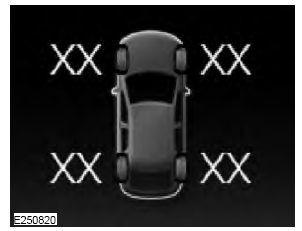|
DTC
|
Description
|
Action
|
|
C110C:11
|
Left Front Damper Solenoid: Circuit Shorted to Ground
|
GO to Pinpoint Test D
|
|
C110C:12
|
Left Front Damper Solenoid: Circuit Shorted to Battery
|
GO to Pinpoint Test D
|
|
C110C:13
|
Left Front Damper Solenoid: Circuit Open
|
GO to Pinpoint Test D
|
|
C110D:11
|
Right Front Damper Solenoid: Circuit Shorted to Ground
|
GO to Pinpoint Test D
|
|
C110D:12
|
Right Front Damper Solenoid: Circuit Shorted to Battery
|
GO to Pinpoint Test D
|
|
C110D:13
|
Right Front Damper Solenoid: Circuit Open
|
GO to Pinpoint Test D
|
|
C110E:11
|
Left Rear Damper Solenoid: Circuit Shorted to Ground
|
GO to Pinpoint Test D
|
|
C110E:12
|
Left Rear Damper Solenoid: Circuit Shorted to Battery
|
GO to Pinpoint Test D
|
|
C110E:13
|
Left Rear Damper Solenoid: Circuit Open
|
GO to Pinpoint Test D
|
|
C110F:11
|
Right Rear Damper Solenoid: Circuit Shorted to Ground
|
GO to Pinpoint Test D
|
|
C110F:12
|
Right Rear Damper Solenoid: Circuit Shorted to Battery
|
GO to Pinpoint Test D
|
|
C110F:13
|
Right Rear Damper Solenoid: Circuit Open
|
GO to Pinpoint Test D
|
|
C1124:55
|
Height Sensor(s): Not Configured
|
This DTC is automatically set in a new VDM and indicates that the system requires height sensor calibration. Once the system is calibrated, the DTC can be cleared. CALIBRATE the VDM and sensors. FOLLOW the diagnostic scan tool instructions
|
|
C1124:56
|
Height Sensor(s): Invalid or Incompatible Configuration
|
This DTC sets when the height sensor voltage is out of range during VDM system height sensor calibration. Once the system is calibrated, the DTC can be cleared.
|
|
C1A03:11
|
Left Front Height Sensor: Circuit Shorted to Ground
|
GO to Pinpoint Test E
|
|
C1A03:12
|
Left Front Height Sensor: Circuit Shorted to Battery
|
GO to Pinpoint Test E
|
|
C1A03:64
|
Left Front Height Sensor: Signal Plausibility Failure
|
-
CHECK the service history for recent service actions related to the VDM. This DTC sets due to incomplete or improper PMI procedures
-
If there have been recent service actions with the VDM, REPEAT the PMI procedure as directed by the diagnostic scan tool.
-
CLEAR the DTC and CARRY OUT the VDM self-test. If the DTC does not return, the repair is complete.
-
If the DTC returns, INSTALL a new VDM.
REFER to: Vehicle Dynamics Control Module (VDM) (204-05 Vehicle Dynamic Suspension, Removal and Installation).
|
|
C1A04:11
|
Right Front Height Sensor: Circuit Shorted to Ground
|
GO to Pinpoint Test E
|
|
C1A04:12
|
Right Front Height Sensor: Circuit Shorted to Battery
|
GO to Pinpoint Test E
|
|
C1A04:64
|
Right Front Height Sensor: Signal Plausibility Failure
|
-
CHECK the service history for recent service actions related to the VDM. This DTC sets due to incomplete or improper PMI procedures
-
If there have been recent service actions with the VDM, REPEAT the PMI procedure as directed by the diagnostic scan tool.
-
CLEAR the DTC and CARRY OUT the VDM self-test. If the DTC does not return, the repair is complete.
-
If the DTC returns, INSTALL a new VDM.
REFER to: Vehicle Dynamics Control Module (VDM) (204-05 Vehicle Dynamic Suspension, Removal and Installation).
|
|
C1A05:11
|
Left Rear Height Sensor: Circuit Shorted to Ground
|
GO to Pinpoint Test E
|
|
C1A05:12
|
Left Rear Height Sensor: Circuit Shorted to Battery
|
GO to Pinpoint Test E
|
|
C1A05:64
|
Left Rear Height Sensor: Signal Plausibility Failure
|
-
CHECK the service history for recent service actions related to the VDM. This DTC sets due to incomplete or improper PMI procedures
-
If there have been recent service actions with the VDM, REPEAT the PMI procedure as directed by the diagnostic scan tool.
-
CLEAR the DTC and CARRY OUT the VDM self-test. If the DTC does not return, the repair is complete.
-
If the DTC returns, INSTALL a new VDM.
REFER to: Vehicle Dynamics Control Module (VDM) (204-05 Vehicle Dynamic Suspension, Removal and Installation).
|
|
C1A06:11
|
Right Rear Height Sensor: Circuit Shorted to Ground
|
GO to Pinpoint Test E
|
|
C1A06:12
|
Right Rear Height Sensor: Circuit Shorted to Battery
|
GO to Pinpoint Test E
|
|
C1A06:64
|
Right Rear Height Sensor: Signal Plausibility Failure
|
-
CHECK the service history for recent service actions related to the VDM. This DTC sets due to incomplete or improper PMI procedures
-
If there have been recent service actions with the VDM, REPEAT the PMI procedure as directed by the diagnostic scan tool.
-
CLEAR the DTC and CARRY OUT the VDM self-test. If the DTC does not return, the repair is complete.
-
If the DTC returns, INSTALL a new VDM.
REFER to: Vehicle Dynamics Control Module (VDM) (204-05 Vehicle Dynamic Suspension, Removal and Installation).
|
|
P1758:19
|
Pressure Solenoid Control System Incorrect Current: Circuit Current Above Threshold
|
GO to Pinpoint Test C
|
|
U0100:87
|
Lost Communication with ECM / PCM "A": Missing Message
|
GO to Pinpoint Test F
|
|
U0121:87
|
Lost Communication with Anti-Lock Brake System (ABS) Control Module: Missing Message
|
GO to Pinpoint Test G
|
|
U0131:87
|
Lost Communication with Power Steering Control Module: Missing Message
|
GO to Pinpoint Test H
|
|
U0137:87
|
Lost Communication with Trailer Brake Control Module: Missing Message
|
GO to Pinpoint Test I
|
|
U0140:87
|
Lost Communication with Body Control Module: Missing Message
|
GO to Pinpoint Test J
|
|
U0151:87
|
Lost Communication with Restraints Control Module: Missing Message
|
GO to Pinpoint Test K
|
|
U0401:00
|
Invalid Data Received from ECM / PCM "A": No Sub Type Information
|
-
This DTC sets in continuous memory if any one of the following PCM
messages contains "invalid" instead of the actual message data;
accelerator pedal position, ambient air temperature, driven wheel
torque, engine RPM data, power pack status, gear lever position or
vehicle speed.
-
Using a diagnostic scan tool, RETRIEVE and DIAGNOSE all PCM and GWM Diagnostic Trouble Codes (DTCs).
REFER to: Communications Network (418-00 Module Communications Network, Diagnosis and Testing).
REFER to: Electronic Engine Controls (303-14B Electronic Engine Controls - 2.0L EcoBoost (184kW/250PS) – MI4, Diagnosis and Testing).
REFER to: Electronic Engine Controls (303-14B Electronic Engine Controls - 2.0L EcoBoost (184kW/250PS) – MI4, Diagnosis and Testing).
REFER to: Electronic Engine Controls (303-14B Electronic Engine Controls - 2.0L EcoBoost (184kW/250PS) – MI4, Diagnosis and Testing).
-
If the diagnostic scan tool cannot communicate with the PCM or GWM,
REFER to: Communications Network (418-00 Module Communications Network, Diagnosis and Testing).
-
If there are no Diagnostic Trouble Codes (DTCs) in the PCM or GWM, the condition may be caused by an intermittent concern.
-
SET the ignition to OFF. DISCONNECT and INSPECT all PCM electrical connectors, GWM
electrical connectors and related in-line connectors for corrosion,
bent pins, pushed-out pins and spread terminals. REPAIR as necessary.
|
|
U0415:00
|
Invalid Data Received from Anti-Lock Brake System (ABS) Control Module: No Sub Type Information
|
-
This DTC sets in continuous memory if any one of the following ABS module messages contains "invalid" instead of the actual message data; ABS
active, brake torque request, stability control mode, stability control
indicator request, traction control mode, vehicle lateral acceleration,
vehicle longitudinal acceleration, vehicle roll rate or vehicle
vertical acceleration.
-
Using a diagnostic scan tool, RETRIEVE and DIAGNOSE all ABS module Diagnostic Trouble Codes (DTCs).
REFER to: Anti-Lock Brake System (ABS) and Stability Control (206-09 Anti-Lock Brake System (ABS) and Stability Control, Diagnosis and Testing).
-
If the diagnostic scan tool cannot communicate with the ABS module,
REFER to: Communications Network (418-00 Module Communications Network, Diagnosis and Testing).
-
If there are no Diagnostic Trouble Codes (DTCs) in the ABS module, the condition may be caused by an intermittent concern.
-
SET the ignition to OFF. DISCONNECT and INSPECT all ABS
module electrical connectors and related in-line connectors for
corrosion, bent pins, pushed-out pins and spread terminals. REPAIR as
necessary.
|
|
U0420:00
|
Invalid Data Received from Power Steering Control Module: No Sub Type Information
|
-
The steering angle information is sent to the VDM from the PSCM.
-
This DTC sets in continuous memory if the steering angle data message contains "invalid" instead of actual steering angle data.
-
Using a diagnostic scan tool, RETRIEVE and DIAGNOSE all PSCM Diagnostic Trouble Codes (DTCs).
 Click here to access Guided Routine (EPAS).
Click here to access Guided Routine (EPAS). Internet Explorer version 11 or greater is required to perform this Pinpoint Test. Internet Explorer version 11 or greater is required to perform this Pinpoint Test.
-
If the diagnostic scan tool cannot communicate with the PSCM,
REFER to: Communications Network (418-00 Module Communications Network, Diagnosis and Testing).
-
If there are no Diagnostic Trouble Codes (DTCs) in the PSCM, the condition may be caused by an intermittent concern.
-
SET the ignition to OFF. DISCONNECT and INSPECT all PSCM
electrical connectors and related in-line connectors for corrosion,
bent pins, pushed-out pins and spread terminals. REPAIR as necessary.
|
|
U0422:00
|
Invalid Data Received from Body Control Module: No Sub Type Information
|
-
This DTC sets in continuous memory if any one of the following BCM messages contains "invalid" instead of the actual message data.
-
Using a diagnostic scan tool, RETRIEVE and DIAGNOSE all BCM Diagnostic Trouble Codes (DTCs).
REFER to: Body Control Module (BCM) (419-10 Multifunction Electronic Modules, Diagnosis and Testing).
-
If the diagnostic scan tool cannot communicate with the BCM,
REFER to: Communications Network (418-00 Module Communications Network, Diagnosis and Testing).
-
If there are no Diagnostic Trouble Codes (DTCs) in the BCM, the condition may be caused by an intermittent concern.
-
SET the ignition to OFF and WAIT one minute. DISCONNECT and INSPECT all BCM
electrical connectors and related in-line connectors for corrosion,
bent pins, pushed-out pins and spread terminals. REPAIR as necessary.
|
|
U0452:00
|
Invalid Data Received from Restraints Control Module: No Sub Type Information
|
-
This DTC sets in continuous memory if any one of the following RCM
messages contains "invalid" instead of the actual message data; vehicle
lateral acceleration, vehicle longitudinal acceleration or vehicle roll
rate.
-
Using a diagnostic scan tool, RETRIEVE and DIAGNOSE all RCM Diagnostic Trouble Codes (DTCs).
REFER to: Airbag Supplemental Restraint System (SRS) (501-20B Supplemental Restraint System, Diagnosis and Testing).
-
If the diagnostic scan tool cannot communicate with the RCM,
REFER to: Communications Network (418-00 Module Communications Network, Diagnosis and Testing).
-
If there are no Diagnostic Trouble Codes (DTCs) in the RCM, the condition may be caused by an intermittent concern.
-
SET the ignition to OFF and WAIT one minute. DISCONNECT and INSPECT all RCM
electrical connectors and related in-line connectors for corrosion,
bent pins, pushed-out pins and spread terminals. REPAIR as necessary.
|
|
U1000:00
|
Solid State Driver Protection Active-Driver Disabled: No Sub Type Information
|
-
CLEAR the DTC. CARRY OUT the VDM module self-test.
-
If the DTC returns, INSTALL a new VDM.
REFER to: Vehicle Dynamics Control Module (VDM) (204-05 Vehicle Dynamic Suspension, Removal and Installation).
|
|
U200D:11
|
Control Module Output Power A: Circuit Short to Ground
|
GO to Pinpoint Test E
|
|
U200D:12
|
Control Module Output Power A: Circuit Short to Battery
|
GO to Pinpoint Test E
|
|
U200E:11
|
Control Module Output Power B: Circuit Short to Ground
|
GO to Pinpoint Test E
|
|
U200E:12
|
Control Module Output Power B: Circuit Short to Battery
|
GO to Pinpoint Test E
|
|
U2024:51
|
Control Module Cal-Config Data: Not Programmed
|
-
This DTC sets due to incomplete or improper flash programming procedures.
-
REPEAT the flash programming procedure as directed by the diagnostic scan tool.
-
CLEAR the DTC and CARRY OUT the VDM self-test. RETRIEVE and RECORD all Diagnostic Trouble Codes (DTCs).
-
If the DTC does not return, the repair is complete.
-
If the DTC returns, INSTALL a new VDM.
REFER to: Vehicle Dynamics Control Module (VDM) (204-05 Vehicle Dynamic Suspension, Removal and Installation).
|
|
U2100:00
|
Initial Configuration Not Complete: No Sub Type Information
|
-
This DTC is pre-set in a new VDM and clears automatically when the VDM is configured correctly
-
CONNECT the diagnostic scan tool and CARRY OUT the PMI procedure as directed by the diagnostic scan tool
-
CLEAR the DTC. CARRY OUT the VDM self-test. RETRIEVE and RECORD all Diagnostic Trouble Codes (DTCs).
-
If the DTC does not return, the repair is complete.
-
If the DTC returns, INSTALL a new VDM.
REFER to: Vehicle Dynamics Control Module (VDM) (204-05 Vehicle Dynamic Suspension, Removal and Installation).
|
|
U2200:00
|
Control Module Configuration Memory Corrupt: No Sub Type Information
|
-
CLEAR the DTC. CARRY OUT the VDM module self-test.
-
If the DTC returns, INSTALL a new VDM.
REFER to: Vehicle Dynamics Control Module (VDM) (204-05 Vehicle Dynamic Suspension, Removal and Installation).
|
|
U3000:04
|
Control Module: System Internal Failure
|
-
CLEAR the DTC. CARRY OUT the VDM module self-test.
-
If the DTC returns, INSTALL a new VDM.
REFER to: Vehicle Dynamics Control Module (VDM) (204-05 Vehicle Dynamic Suspension, Removal and Installation).
|
|
U3000:49
|
Control Module: Internal Electronic Failure
|
-
CLEAR the DTC. CARRY OUT the VDM module self-test.
-
If the DTC returns, INSTALL a new VDM.
REFER to: Vehicle Dynamics Control Module (VDM) (204-05 Vehicle Dynamic Suspension, Removal and Installation).
|
|
U3003:16
|
Battery Voltage: Circuit Voltage Below Threshold
|
GO to Pinpoint Test A
|
|
U3003:17
|
Battery Voltage: Circuit Voltage Above Threshold
|
GO to Pinpoint Test B
|
 PINPOINT TEST A : U3003:16
PINPOINT TEST A : U3003:16  PINPOINT TEST B : U3003:17
PINPOINT TEST B : U3003:17 PINPOINT TEST C : P1758:19
PINPOINT TEST C : P1758:19 PINPOINT TEST D : DAMPER SOLENOID ELECTRICAL FAULTS
PINPOINT TEST D : DAMPER SOLENOID ELECTRICAL FAULTS PINPOINT TEST E : HEIGHT SENSOR ELECTRICAL FAULTS
PINPOINT TEST E : HEIGHT SENSOR ELECTRICAL FAULTS PINPOINT TEST F : U0100:87
PINPOINT TEST F : U0100:87 PINPOINT TEST G : U0121:87
PINPOINT TEST G : U0121:87 PINPOINT TEST H : U0131:87
PINPOINT TEST H : U0131:87 PINPOINT TEST I : U0137:87
PINPOINT TEST I : U0137:87 PINPOINT TEST J : U0140:87
PINPOINT TEST J : U0140:87 PINPOINT TEST K : U0151:87
PINPOINT TEST K : U0151:87 Vehicle Dynamic Suspension - System Operation and Component Description. Description and Operation
Vehicle Dynamic Suspension - System Operation and Component Description. Description and Operation Front Suspension Height Sensor. Removal and Installation
Front Suspension Height Sensor. Removal and Installation

 Click here to access Guided Routine (EPAS).
Click here to access Guided Routine (EPAS). Internet Explorer version 11 or greater is required to perform this Pinpoint Test.
Internet Explorer version 11 or greater is required to perform this Pinpoint Test..jpg) PINPOINT TEST A : U3003:16
PINPOINT TEST A : U3003:16 



















































































 Click here to access Guided Routine (PCM).
Click here to access Guided Routine (PCM). Internet Explorer version 11 or greater is required to perform this Pinpoint Test.
Internet Explorer version 11 or greater is required to perform this Pinpoint Test. Click here to access Guided Routine (EPAS).
Click here to access Guided Routine (EPAS). Internet Explorer version 11 or greater is required to perform this Pinpoint Test.
Internet Explorer version 11 or greater is required to perform this Pinpoint Test. Click here to access Guided Routine (EPAS).
Click here to access Guided Routine (EPAS). Internet Explorer version 11 or greater is required to perform this Pinpoint Test.
Internet Explorer version 11 or greater is required to perform this Pinpoint Test. Click here to access Guided Routine (BCM).
Click here to access Guided Routine (BCM). Internet Explorer version 11 or greater is required to perform this Pinpoint Test.
Internet Explorer version 11 or greater is required to perform this Pinpoint Test.